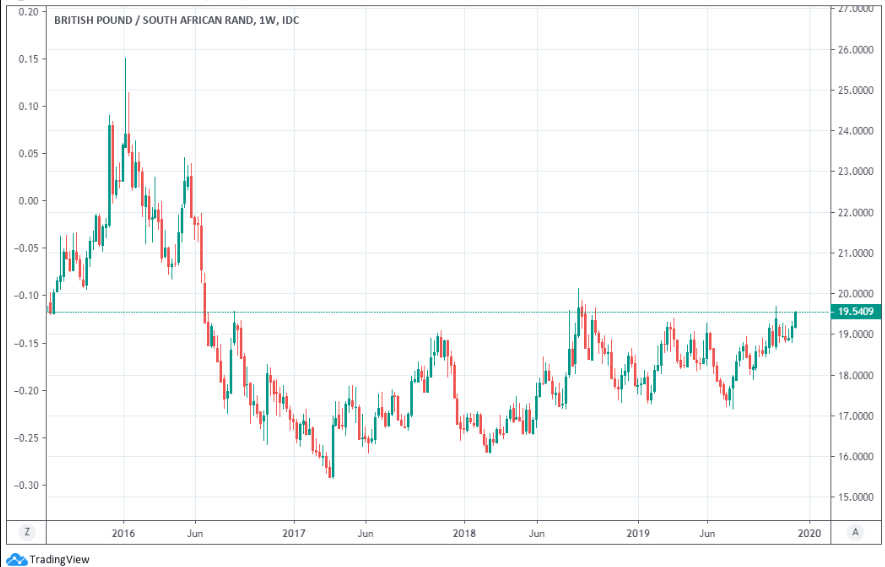Pound-South African Rand Exchange Rate hits 19.50 on Eskom Woes
- Written by: James Skinner

Image © Government of South Africa
- SA economy suffers stage 4 load-shedding and mine closures.
- Final-quarter growth performance could be trashed if continued.
- ZAR eyes decisions on Fed rates and the next U.S.-China tariffs.
- Fed to signal steady rates ahead as U.S.-China threat lingers on.
- Tariffs to hit rest of Chinese exports unless Trump says otherwise.
- BofA Global Research sees ZAR weakness in Dec, recovery in 2020.
- GBP/ZAR seen hitting new high by month-end, advancing in 2020.
The South African Rand on Tuesday suffered its largest daily drop against the Pound, Dollar and other major currencies after load-shedding at troubled power utility Eskom shuttered some of the country’s mines, which are a key foreign exchange earner for Africa's largest economy.
The impact to industry of advanced load shedding caught financial markets by surprise, prompting traders to sell the Rand, which is also liable to take direction from an impending U.S. Federal Reserve decision and a White House decision on whether or not to go ahead and impose a tranche of tariffs on China on December 15.
The Pound-to-Rand exchange rate rose 1.36% amidst the broad-based selling of ZAR, reaching 19.50, its highest rate since October. The Dollar-to-Rand exchange rate meanwhile rose 1.16% to reach 14.82 and the Euro-to-Rand exchange rate rose 1.3% to quote at 16.43.
Eskom on Monday commenced ‘stage four’ load-shedding, leading to rolling blackouts across the nation and prompting some of South Africa’s minds to halt operations for the time being, with the ailing electricity monopoly saying the measures are necessary due to a “shortage of capacity with a number of generating units due to breakdowns.”
Load-shedding has already been ongoing for four days although was previously of a less severe ‘stage 2’, and is set to continue until at least 23:00 Tuesday. Given the degree to which manufacturers, miners and other industrial businesses are reliant on energy, load-shedding at Eskom can have a serious adverse impact on the economy.
And with South African GDP already falling 0.6% in the third quarter, any continuation of it might plunge the country into its second technical recession in as many years.
"Some of the consequences of this new level of load-shedding have been immediate – the Rand nosedived 11 cents to 14.69 against the greenback. Some mining operations took the unprecedented step of cancelling their night shift on Monday – a full shift’s worth of production lost – which not only means that mining production will take a hit, but it could also negatively impact employment in the industry, especially should stage 4 and above load-shedding continue,” says Siobhan Redford, an economist at Rand Merchant Bank.

Above: South African Rand performance Vs major rivals on Tuesday. Source: Pound Sterling Live.
Petra Diamonds, South Africa’s largest miner of precious stones, has shuttered mines and sidelined workers in response to outage and more mining and non-mining companies might be forced to follow suit if the outages continue. Years of underinvestment, mismanagement and corruption have seen Eskom’s generating capacity decay to an extent where it’s often no longer able to keep the country’s lights on. And with the company unable to service its mammoth debt pile from its revenues, and the government on the hook for a substantial amount of that money, the company is the single largest threat to South Africa’s last remaining ‘investment grade’ credit rating.
Fixing sickly state-owned companies like Eskom is high on the wish-list of Moody’s, the last major agency to still rate South Africa an ‘investment grade’ prospect, although it also wants a credible plan from the government for reducing its budget deficit and stemming the increase in national debt. Government is facing expenditure pressures on one side that are in part due to the demands of Eskom and others, while seeing a weak economy eroding its tax base on the income side. Moody’s will announce its next rating decision in February, weeks after the 2020 budget.
Eskom’s load-shedding has hit the Rand as markets wait to hear if President Donald Trump will go ahead with the already-scheduled implementation of tariffs on all of China’s remaining annual exports to the U.S., which is due before Sunday 15, December. He and Commerce Secretary Wilbur Ross have both said recently that without the much-vaunted ‘phase one deal’ to end the trade war, those tariffs will go ahead. And on Tuesday that deal was still elusive, with no word from the White House of a delay to implementation.
“A "phase one" trade deal between the US and China remains elusive with the 15 December no on the near-term horizon. We think it may be a bumpy ride over the next couple of days, but our base case is for the two sides to reach an agreement,” says Mark McCormick, head of FX strategy at TD Securities.

Above: Pound-to-Rand rate shown at daily intervals.
President Trump's trade war has wounded the global manufacturing sector and driven a slowdown in international trade. As the currency of an emerging market country that enjoys a close trade relationship with China, the Rand has also been hurt by the tariff fight and would likely suffer if the White House does not cancel or delay the new round of tariffs.
The White House said on October 11 that it had struck a ‘phase one deal’ to end the tariff fight but since then U.S. language on the subject has changed and recently Trump has said only that such a thing “could be reached."
Sunday’s tariff deadline is the single most important risk event for financial markets in the current week but before word arrives on that score, markets will likely have to first navigate Wednesday’s 19:00 Federal Reserve interest rate decision and digest its implications for investors.
“The trade weighted dollar remains in a tight range (after the decline earlier in the month) reflecting limited anticipation for a change from both the Fed and ECB meetings this week as well as uncertainty about the 15 Dec tariff deadline. Global data today suggest no change to this trend today,” says Petr Krpata, chief EMEA strategist for FX and bonds at ING.

Above: USD/ZAR rate shown at daily intervals.
The Fed is expected to leave its interest rate unchanged at 1.75% Wednesday and to reiterate the new strap-line of rate setters, which is the assertion that the U.S. economy and interest rates are in a “good place” and that it would take a material reassessment of the outlook in order to change that.
South Africa’s Rand might not like to hear that U.S. rates and bond yields are likely to remain around current levels for a while yet because they’re still proving to be a powerful draw for investors, especially during periods of unease over relations with China.
Trade tensions tend to stoke demand for safe-haven currencies like the Dollar, Yen and Swiss Franc while driving investors out of riskier emerging markets.
“ZAR is the most shorted EM currency on our data,” says David Hauner, an EMEA cross-asset strategist at BofA Global Research, the research division of Bank of America. “This is due to a combination of trade deal and local fiscal uncertainty as well as the usual year end reluctance to take strong contrarian views. We think long term ZAR local bonds may be one of the best trades for 2020, especially for Q1. Risk premium is high, and the possible Moody's downgrade and index outflows in Feb/Mar is absolutely consensus now.”
Hauner and the BofA team have an almost contrarian view of, if-not appetite for South African bonds and the Rand at the moment. They’re currently waiting for an opportunity to pile into the bond market and they say such a thing might materialise in the wake of the February Moody’s rating decision.

Above: Pound-to-Rand rate shown at weekly intervals.
Losing the investment grade credit rating could trigger large outflows from the market and Rand, although Hauner and a few others have long said the downgrade could well be in the price of the Rand already.
A lot of investors spoken to by BofA Global Research have appeared to be just biding their time by waiting to step into the market as buyers in the wake of any February downgrade. Many of those client investors are said to be of the view that February’s budget will contain positive surprises, although it remains to be seen if it does and if they’ll be enough to save the top credit rating.
BofA Global Research forecasts the USD/ZAR rate will rise to 15 by year-end but that it’ll decline gently to 14.80 by before the curtain closes on 2020.
The Pound-to-Rand rate is tipped to hit 19.96 by the end of the month before rising to 20.59 before the end of 2020. The latter would be the highest level since the Brexit referendum of June 2016.
Time to move your money? The Global Reach Best Exchange Rate Guarantee offers you competitive rates and maximises your currency transfer. Global Reach can offer great rates, tailored transfers, and market insight to help you choose the best times for you to trade. Speaking to a currency specialist helps you to capitalise on positive market shifts and make the most of your money. Find out more here.
* Advertisement





